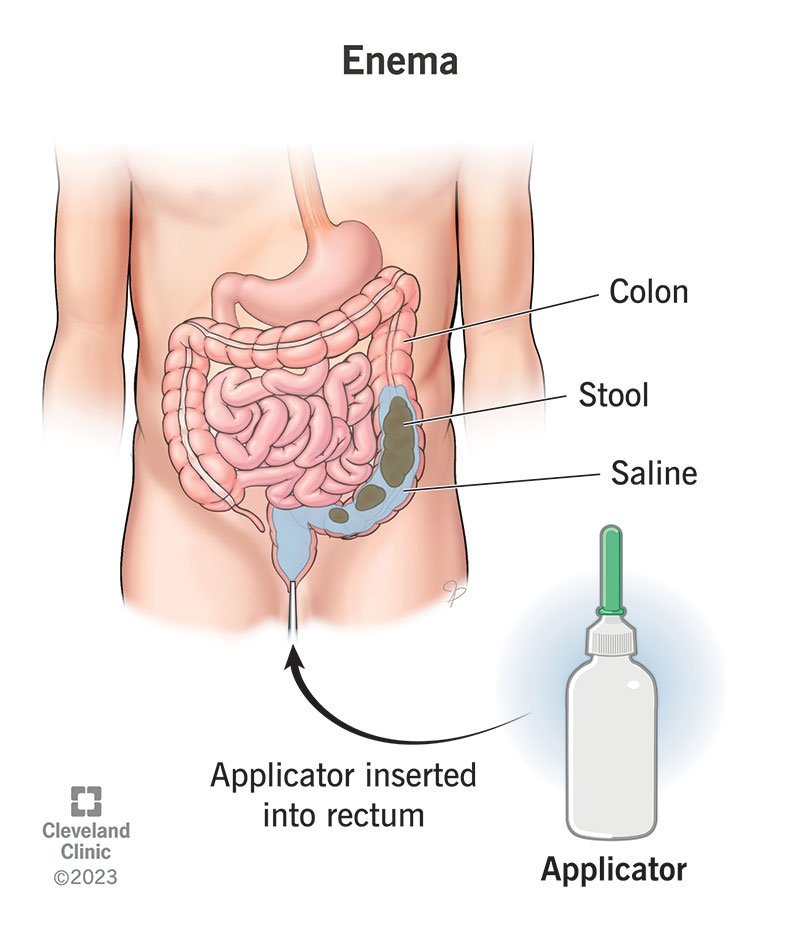An enema involves inserting liquid directly into your rectum to help you poop. Most people use them to relieve constipation that hasn’t improved with other treatments and as a colon cleanse to prepare for a colonoscopy. You can buy enema kits, like Fleet® Saline Enema, over the counter. Use them exactly as directed to prevent complications.
Advertisement
Cleveland Clinic is a non-profit academic medical center. Advertising on our site helps support our mission. We do not endorse non-Cleveland Clinic products or services. Policy

An enema is an injection of fluid directly into your rectum that helps you poop. You may get an enema at your healthcare provider’s office. Most people buy enema kits they use at home. They’re available without a prescription at most pharmacies.
Advertisement
Cleveland Clinic is a non-profit academic medical center. Advertising on our site helps support our mission. We do not endorse non-Cleveland Clinic products or services. Policy
People have used enemas for centuries to flush out poop (stool) in their colon (large intestine).
You may hear people use “enema” to refer to the actual procedure or the fluid or product they use to flush out their colon. Products you’ve likely heard of before, like Fleet® Saline Enema and Pedia Lax®, are commonly used enemas.
You may need an enema to:
Advertisement
Some people use enemas to rid their bodies of toxins or lose weight, but there’s no evidence that enemas help with this.
Enemas come in varieties based on solution type, the enema’s purpose and the solution amount.
Some people mix homemade solutions that consist of ingredients like soap, vinegar, milk or even coffee. Not all homemade ingredients have been tested for safety, though. They can potentially irritate or injure your colon. If you need an enema, it’s worth it to purchase one that’s safe.
Regardless of the enema type, you should follow the instructions — to the letter — to ensure you’re inserting the right amount of fluid. Otherwise, you may experience unpleasant side effects. Too much fluid can damage your colon.
Inserting any fluid into your rectum creates pressure inside your colon, triggering a reflex that makes you poop. This doesn’t mean that inserting any fluid is safe, though.
The enemas you buy over the counter are safe (when administered correctly) and provide additional benefits to help you feel relief fast. For example, they can help you retain water to soften your stool, stimulate your colon to move or lubricate your colon to grease the passageway.
No two enema kits are the same. For example, the container that holds the fluid may be a bottle or a bag. The part that administers the solution may be a tube, a nozzle or a syringe. Follow the instructions on the kit or from your healthcare provider closely.
In general, here are the steps you should follow.
Advertisement
Advertisement
An enema is a safe procedure when done correctly, but errors can happen.
Risks include:
Advertisement
As with any treatment, enemas aren’t for everyone. Check with your healthcare provider to ensure an enema is safe based on your health.
Most enemas provide relief within minutes up to an hour. Read the instructions on the enema kit so you know the timeframe. Contact your healthcare provider if it’s past the window when you should’ve pooped, and nothing’s moving.
With most enemas, you poop within 15 minutes, but it depends on the type of enema you’re using. Some may take up to an hour to clean you out completely. A key benefit of an enema is that it provides instant relief.
It’s a good idea to stay close to the toilet for the first hour after having an enema, just in case.
There’s nothing pleasant about hiding out in the bathroom and waiting to poop (finally). Still, the experience doesn’t have to be agony. You can get a comfortable footstool to rest on while you wait to go. It’s especially helpful for children, whose feet may not be able to reach the floor.
Books, tablets, cell phones and handheld video games are also a good idea. An enema is mostly about pooping, but that doesn’t mean you can’t distract yourself with the news, a good book or even cute cat videos.
Call your healthcare provider if you’re considering using an enema to relieve constipation. There may be simpler solutions that can help.
Don’t hesitate to ask your provider for help if you have any questions about performing the procedure correctly. It’s better to ask than risk an injury.
If you’ve performed an enema and nothing’s moved within the timeframe, contact your provider. Some enemas can lead to dehydration if they stay in your body too long.
The thought of an enema may make you squeamish, but the benefits can outweigh the “ick” factor of the actual process. It’s not a first-line treatment for constipation. Still, an enema can provide relief fast — at that moment when you’re feeling most desperate. Just make sure you’re not relying too much on enemas. That can make your constipation worse in the long run. And follow the instructions on your enema kit down to the last detail. An enema is safe when it’s performed correctly and only as needed.
Cleveland Clinic’s primary care providers offer lifelong medical care. From sinus infections and high blood pressure to preventive screening, we’re here for you.

Last reviewed on 11/20/2023.
Learn more about the Health Library and our editorial process.